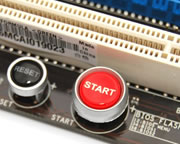Overclocking and Final Thoughts
The Asus Maximus II Formula has left us with mixed feelings, which is a bit of a shame given how excited we were to test this new motherboard in the first place.
The board's feature set is impressive and the performance was acceptable, but we did have a few issues regarding stability. But before I begin to explain the problems we ran into, it should be noted that we have been unable to acquire a new sample of this product, so we cannot rule out the option this may be a problem limited to our sample.
When tested using a Core 2 Duo Q9450 processor, the Maximus II Formula proved to be rock solid. Then we popped in the Q6600 which also worked very well using standard settings. It wasn't until we tried to test this board's overclocking abilities using our Q6600 and E8400 processors that we started to see some issues. At just 3.0GHz the Maximus II Formula would come unstuck when testing with the Q6600, this is a problem that we have never encountered with this processor before.
The system would boot up into Windows Vista perfectly and pass hours of Prime95 as well as various other stress tests. So, what's the problem then you ask? No matter what we did, the board would not survive more than a minute of gaming without promptly rebooting the entire system. No BSOD, no error message, just a quick restart. Asus was unable to help us with the issue, and neither could we find other users complaining about a similar issue anywhere on the net. We will only be able to confirm if this is a problem with our sample, or perhaps the latest BIOS revision 503, if and when we can get a new sample. Therefore, overclocking was a bust for us since we couldn't complete all the required tests.
Having that said, the Maximus II Formula would boot into Windows and run perfectly with our Q6600 set to work at 3.60 GHz, for example, we just couldn't benchmark with any games. At this stage we suspect there could be something wrong with the BIOS, but it is impossible to say for sure without a second board to compare with. Looking past this issue for now, the Maximus II Formula was actually very good in every other aspect.
The dual PCI Express Gigabit LAN controllers are nice, as is the 8-Channel audio supporting Creative EAX 4.0HD. Other more unique features, such as the clear CMOS switch mounted on the I/O panel, and the on-board power and reset buttons are also welcomed additions.
When it comes to board design and layout the Maximus II Formula scores big, and aesthetically is possibly one of the best looking motherboards we have ever seen, if that counts for something. The large heatsinks, which also use heatpipes, are screwed onto the motherboard rather than clipped. This makes for better contact with the board and does not allow the large heatsinks to move around.
Overall the Asus Maximus II Formula looks to be a solid product and we hope that the strange stability issues that we ran into when overclocking are either limited to our sample or this BIOS revision.
But as impressive as the Maximus II Formula looks to be, at roughly $280 it is far from affordable, particularly when the P5Q Deluxe costs just $200. For now we will continue to work on our overclocking issues with this board and update the review with our findings at a later time.
